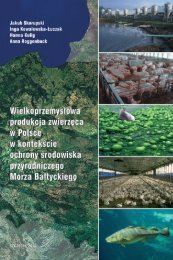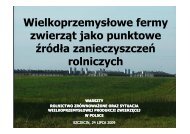best available technologies for manure treatment - Baltic Green Belt
best available technologies for manure treatment - Baltic Green Belt
best available technologies for manure treatment - Baltic Green Belt
Create successful ePaper yourself
Turn your PDF publications into a flip-book with our unique Google optimized e-Paper software.
Best Available Technologies <strong>for</strong> <strong>manure</strong> <strong>treatment</strong> baltic sea 2020<br />
4: RESULT OF DATA ANALYSIS<br />
Such research would also clarify whether it politically<br />
could be made more feasible to implement thermal<br />
gasification and combustion.<br />
4.1.10: Possible difficulties <strong>for</strong> the<br />
deployment of the recommended<br />
<strong>technologies</strong><br />
Considering the recommended <strong>technologies</strong> there<br />
are especially the following difficulties <strong>for</strong> their<br />
deployment:<br />
• There is at policy level a need to spread in<strong>for</strong>mation<br />
about the livestock <strong>manure</strong> <strong>treatment</strong> <strong>technologies</strong><br />
and their beneficial influence on the<br />
leaching and other environmental parameters.<br />
Secondly it is a challenge to promote the required<br />
policy actions in <strong>for</strong>m of legislation, standards,<br />
and support schemes.<br />
• On the administrative level, the challenges are in<br />
relation to the administration of the IPPC Directive<br />
as well as the BREF document, both being in<br />
the beginning of a revision process, to<br />
- re-consider the Annex 1 list of installations<br />
to ensure as well that off-farm <strong>treatment</strong>s<br />
of livestock <strong>manure</strong>s are carried out in a<br />
regulated way;<br />
- give more emphasis to livestock <strong>manure</strong><br />
<strong>treatment</strong> <strong>technologies</strong> in the BREF document,<br />
including being more specific about<br />
the condition <strong>for</strong> their deployment, to<br />
expand the description of them, and to<br />
add <strong>technologies</strong> that have emerged since<br />
the last revision of the BREF document;<br />
- introduce the use of N and P leaching<br />
as objective criteria <strong>for</strong> the inclusion of<br />
BAT’s in the BREF document, both<br />
generally, but also specifically concerning<br />
livestock <strong>manure</strong> <strong>treatment</strong> <strong>technologies</strong>.<br />
• Thermal gasification and combustion are <strong>technologies</strong><br />
that are regulated under both waste handling<br />
and heating regulations. It is especially<br />
troublesome and expensive to deal with the waste<br />
combustion regulations <strong>for</strong> farm-scale plants,<br />
because they must be commissioned, registered,<br />
monitored, and have systems <strong>for</strong> cleaning of<br />
the flue gas. Changes in excise taxation of the heat<br />
produced at such plants could be implemented,<br />
or via spatial planning it could be <strong>for</strong>bidden to<br />
establish own heating plants or heating plants that<br />
do not use a prescribed fuel.<br />
• Both plants <strong>for</strong> anaerobic digestion, thermal<br />
gasification, and combustion would, dependent<br />
on the specific target country as well as national<br />
definitions, require environmental permits, and it<br />
can be difficult and time consuming to find<br />
suitable locations <strong>for</strong> such a plants.<br />
• Anaerobic digestion plants, and in general all<br />
“hardware” <strong>technologies</strong>, are expensive and require<br />
extra binding of capital in the production system<br />
of resources with a negative or a doubtful return.<br />
The binding of capital in the livestock <strong>manure</strong><br />
<strong>treatment</strong> <strong>technologies</strong> poses an extra risk <strong>for</strong> a<br />
farm, because the alternative use of the investment<br />
might be low in case the farmer stops livestock<br />
production.<br />
• Any <strong>technologies</strong> that result in products that are<br />
intended <strong>for</strong> sale/export out of the farm/region<br />
have the drawbacks that the markets do not exist<br />
or are not developed <strong>for</strong> the products. Marketing<br />
of such products requires, as en<strong>for</strong>ced by the<br />
legislation, that the producers are registered,<br />
follow some Hazard Analysis Critical Control<br />
Point (HACCP) schemes, label their products,<br />
and guarantee the content of plant nutrients of<br />
them. These requirements are in themselves<br />
difficult and expensive to deal with, and are<br />
almost unrealistic <strong>for</strong> farm-scale installations.<br />
4.2: Efficiency of the IPPC Directive to<br />
promote <strong>best</strong> <strong>available</strong> technology<br />
<strong>for</strong> <strong>manure</strong> <strong>treatment</strong><br />
The questionnaire and interviews give a homogenous<br />
indication on stakeholders view on the efficiency of<br />
the IPPC Directive to promote <strong>best</strong> <strong>available</strong> <strong>treatment</strong><br />
of <strong>manure</strong>. Generally, the respondents consider<br />
the implementation of the IPPC legislation to be<br />
effective, but that leaching of N and P to water and<br />
effective <strong>manure</strong> <strong>treatment</strong> <strong>technologies</strong> is not given<br />
high attention in the legislation.<br />
The current Reference Document on Best Available<br />
Techniques <strong>for</strong> Intensive Rearing of Poultry<br />
and Pigs (BREF) was adopted in June 2003. It is a<br />
35








